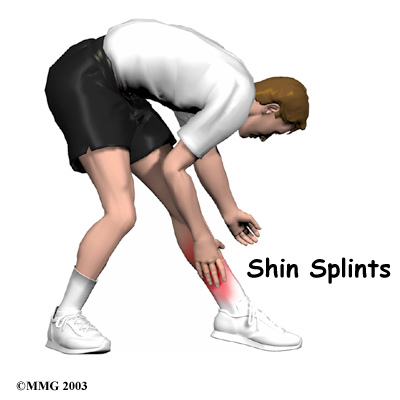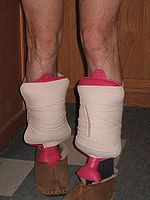Shin splint
Shin splints, also known as Medial Tibial Stress Syndrome, is a painful injury that often occurs in runners and athletes who put a lot of stress on their lower leg. It is considered to be an "overuse" injury. The pain comes from the trauma in the muscles, tendons, and other tissues at the point of attachment to the bone. The tendons are particularly traumatized because they are being partially torn away from the bone.
Causes
The causes splints and can be separated into two different categories: Overload, and Biomechanical Inefficiencies. When discussing shin splints overload simply means training errors, whereas biomechanical inefficiencies refer to errors in the way exercise is performed.
Overload
When discussing training errors, it must first be realize that shin splints are not caused by exercise, but rather the repeated shock and stress that our muscles, tendons, and bones undergo during exercise. Also remember that exhausted muscles loose their ability to adequately absorb the shock and stress that is constantly encountered throughout exercise.[1] One of the many causes for shin splints is exercising on hard surfaces such as concrete and wood floors, as well as running on the street and at tracks. This is one of the key causes of shin splints for athletes who play multiple sports and transition from a sport in which they are running on a grass or turf field to one where they are running on a gym floor. Another way one can get shin splints is by abruptly beginning to exercise after a long period of no exercise, as well as the rapid escalation of exercise without the proper amount of rest time or muscle adaptation. The increase of hill workouts such as running up and down hills, can also be a major contributor to shin splints. The use of ill-fitting or worn-out footwear while working out is a sure way to quickly acquire an injury. Without proper shock absorbing shoes that give good support, the likelihood of getting shin splints increases.[2]
Bio-mechanical Inefficiencies
Biomechanical inefficiencies are factors that negatively affect the way exercise is performed, and are not as evident as where an athlete exercises or how much they exercise. Having flat feet is the most significant biomechanical cause for shin splints, and over-pronation of the foot is the second.[1] Over-pronation, or the extreme inward rolling, of the foot and ankle forces the tibia to turn in such a way that the muscles and ligaments surrounding the bone become stressed. Another inefficiency that contributes to shin splints are tight and stiff muscles. This is a dangerous problem for anyone who exercises, because cold and stiff muscles are much easier to injure than warm muscles that have been thoroughly stretched. Even improper stretching can lead to an injury because it can either stretch the incorrect muscle groups or stretch them in the wrong way. Other mechanics as simple as leaning excessively forward or backward while running can increase the likelihood of getting shin splints. Landing on the balls of the feet, and running with toes pointed outward can also be instrumental. [1]
Symptoms
There are quite a few symptoms of shin splints, the most common is pain. Typically, pain is reported to be on the middle front of the lower leg near the tibia and is often described as being approximately four to six inches in length. The pain is often a dull ache at first, but with the continuation or increase of exercise, the pain itself can become so extreme that the workout must be stopped.[3] Sometimes, the pain will dissipate during the work-out, but aching pain will return after exercise and can be worse the next morning. Pain may increase after running or jumping on hard surfaces such as the street, track, or gym floors. Another symptom is pain in the injured area when the toes or feet are pointed downward. There is occasionally some swelling around the injured area, and lumps and bumps can often be felt when examining the inside of the shin with fingers.[4] One symptom that may or may not be present is redness over the inside of the shin. [4]
Get immediate attention if they following is experienced:[5]
- Severe pain after a fall or an accident
- A hot and inflamed shin
- Swelling worsens
- Pain continues during rest
Treatment
The very first thing that should be done in the treatment of shin splints is the removal of the cause. [1] Whether this means taking a break from exercising, getting new shoes, or moving to a different location to train, it must be done. Many times athletes or coaches decide that the best thing to do is just “run through it” or “push through the pain”. This can be dangerous for the athlete because the symptoms as well as the actual injury, can become worse. There are two types of very similar treatment methods that are both popular to use: the R.I.C.E.R. method, and the Relative Rest approach.
R.I.C.E.R. method
The R.I.C.E.R. method is a very simple way to relieve the pain of shin splints, as well as to help the injury heal. It should be applied for at least the first forty-eight to seventy-two hours. The first “R” stands for rest. This is a very important part of recovery. However, most athletes overlook this because they think they cannot afford to waste the time. The “I” stands for ice, which is one of an athlete’s best friends. The ice is used to lower any swelling or inflammation that may have occurred, as well as help with the blood flow to the injury. The “C” stands for compression. Using tools such as elastic bandages or compression sleeves, which can be bought at the store, can do this; they also help to stop and reduce swelling.[5] The “E” stands for elevation. Elevation is also key in helping to reduce swelling because when the injured leg is held above the heart, the swelling will be able to drain away from the injury site. The final “R” stands for referral to a professional. This is especially important because sometimes it is assumed that shin splints are the reason for pain, and in reality it is a stress fracture or other type of injury. In going to a professional it can be determined by an X-ray, and further damage is not caused.
R=Rest, I=Ice, C=Compression, E=Elevation, R=Referral to professional
Relative Rest approach
The relative rest approach is a compromise between the total rest approach and the “run through it” mindset. The total rest approach is unsatisfactory to athletes who are serious about competition, and the “run through it” approach is dangerous for athletes, hence the relative rest approach. The first thing to do is to stop the exercise that increases pain, but instead do other types of cardio work-outs that take the stress and weight off the injury. Workouts such as pool running and stationary bicycling are excellent ways to accomplish this. Icing the injured leg(s) is also a key to reducing the inflammation. Taking anti-inflammatory medicines such as Ibuprofen and Naproxen is a part of the relative rest approach, however it is good to talk to a professional about it.[3] Another recommendation, is the wearing of a four-inch wide Ace bandage around the injury. Strengthening and stretching the calf and anterior part of the leg is also an important part of the treatment because oftentimes the tightness of the calf muscles can help to cause even more stress to be placed on the shin. Stretching it twice a day is recommended.[3] Probably one of the most important parts to keeping shin splints away after recovering is finding running shoes that are made for ones foot type. Custom made shoes are probably not necessary, but custom-made orthotics may be needed for certain feet since they are designed to give support.
Once all the symptoms of shin splints fade, it is important that there is no rushing into exercising. Starting off slowly and gradually building up endurance and speed is key to not re-injuring the shins. First off, the athlete should choose to run on a completely level terrain that is also soft. This will allow exercising to be accomplished without stress being placed on the former injury. An athlete should also be running only half (50%) the distance of what they previously ran, as well as not running more than half of their pre-injury speed to start out with.[3] After a three to six week period in which no symptoms return, the distance may gradually be increased. But only after all the previous steps have been taken, with no symptoms, can the pace or speed be gradually increased.[3]
Prevention
The most proactive step a runner or athlete can take to prevent shin splints is to visit a professional podiatrist and receive a foot-strike and gait analysis. Once accomplished, the podiatrist can recommend special shoes or arch supports that will help to protect your feet and legs from further injury. Choosing the right shoes can take a lot of the stress away from the shins, and runners should replace their shoes every 350-500 miles.[5] Arch supports help athletes and runners who have flat arches by removing the pain of shin splints. Cross training is another way to prevent shin splints. Participating in low impact exercises such as bicycling and swimming allow athletes to keep physically fit, but not stress their shins. When exercising, it is very important for athletes to completely warm up and go through a stretching routine. This lessens the likelihood of injuring or re-injuring anything. Adding strength and conditioning exercises to daily routines is another way athletes build up and protect their bodies. Also, athletes that increase their workout only by ten percent per week at most allow their bodies time to adjust and get stronger. And finally, the easiest way to prevent a re-injury of shin splints, is to not repeat the same cause of injury.[4]
References
- ↑ 1.0 1.1 1.2 1.3 Shin Splints and Shin Splints Treatment The Stretching Handbook
- ↑ Shin Splints: A Simplified Clinical Classification by Stephen M. Pribut, DPM. Dr. Stephen M. Pribut's Sport Pages
- ↑ 3.0 3.1 3.2 3.3 3.4 MedicineNet.com
- ↑ 4.0 4.1 4.2 SportsInjuryClinic.net
- ↑ 5.0 5.1 5.2 MayoClinic.com
External Links
- MedicineNet.com
- Mayo Clinic
- The Stretching Handbook
- Dr. Pribut
- About.com
- About.com
- The National Library of Medicine
- Sports Med Web
- Sports Injury Clinic


